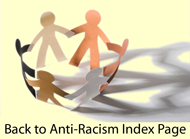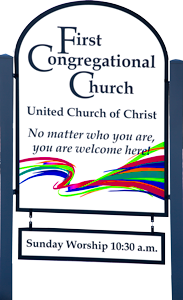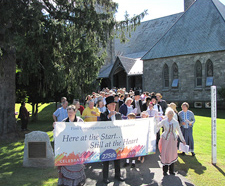Anti-Racism Ministry

What do we mean when we say that racism in the United States is a system?
Some of what we mean is:
Racism is not simply individual acts of meanness or hatred, or even negative thoughts about someone based on their race. Racism in the United States is a system in which white people as a whole are dominant and have the dominant share of wealth, power, prestige, access, and entitlement. People of color as a whole (people of African, Asian, Latino or Native heritage) are subordinated and on average have less wealth, power, prestige, access and entitlement.
Racism is ingrained in our history, our institutions, our culture, in our separation from each other and in our interactions with each other. Racism manifests itself in our educational system, economic system, financial system, health care system, religious institutions, political system, news media, criminal justice system, etc.
Our history and its legacy
What is now the United States was acquired by stealing land from the Native people (and the attempted genocide of those people), and later by taking a large part of what was Mexico by military conquest. Much of the wealth of the country, North and South, was created by the labor of enslaved Africans and their descendents, working primarily, but not exclusively, in the South. That land and that wealth have never been returned to native peoples and people of African heritage, nor paid for.
More than two centuries of enslavement of African-heritage people were followed by another century of Jim Crow laws and lynchings, and then by further racial discrimination that continues to this day and includes all types of people of color.
Government policy favoring white people and contributing to white wealth
Through homesteading arrangements and later through mortgage subsidies and backing, the federal government helped white people obtain land and housing, through programs that excluded people of color. Over time these houses and land rose in value year after year, creating the wealth of the white middle class. Affirmative action for, and wealth transfer to, white people have been government policy through much of our history. Average white family wealth today is roughly twenty times the average family wealth of black and brown families.
Public schools are still significantly financed by property taxes widely resulting in inferior schools for black and brown children and, on average, better schools for children in predominately white communities. School curricula across the country generally feature the history, literature, the accomplishments and the culture of white people tremendously out of proportion to those of people of color. Most of this is taught by white teachers, with excellent intentions, but with relatively little experience with people of color and little training in how to work in multicultural settings. Not surprisingly, school achievement results continue to show white students being more successful in school.
Similarly there is a long history of denying people from various Asian countries the right to U.S. citizenship and land ownership, or the right to immigrate here. While some Asian communities now have higher incomes and school performance, many Asians still report being excluded, not trusted, denied leadership positions, and treated as “foreign” even after multiple generations in this country.
Discrimination today
Housing discrimination, employment discrimination, inequitable lending practices, and unequal health care, all harming people of color, are well documented right up to the present time.
Today, although studies show that white and black men use illegal drugs in equal percentages, black men are incarcerated at ten times the rate of white men on drug charges. The statistics are similar for Latino men. More black men are under the control of the correctional system today than were enslaved in 1850. Black and brown people routinely receive greater sentence than white people for the same crimes. The incarceration rate of the United States is the highest in the world. We live in the age of mass incarceration, with a huge disproportion of that being people of color.
Police violence toward black and brown men and boys, racial profiling, and an ongoing pattern of racial injustice by police departments in numerous cities, in both the North and the South, have recently made the news and been documented by the federal Department of Justice. This is systemic and widespread – Cleveland as well as Ferguson, MO; Staten Island, NY, as well Baltimore; Oakland, CA as well as North Charleston, South Carolina.
Anti-black, anti-Latino, anti-Muslim, anti-immigrant sentiments are widely expressed in the political sphere and often go unchallenged, un-rebutted, and un-apologized for.
Some of the effects
Most major corporations and financial institutions are controlled by white people. Public officials at the local, state, and federal level are disproportionally white. Most people who influence our political system through large donations and extensive lobbying are white. Despite some prominent exceptions, the vast majority of power in this county is in the hands of white people.
Most white people live in predominately white communities and socialize primarily with other white people. Primarily due to housing patterns, schools in the U.S. today are more segregated than they were in the 1950’s, before Brown vs. Board of Education supposedly desegregated the schools.
Environmental justice, climate change and racism
Toxic waste dumps and air polluting coal plants are disproportionally located near where black and brown people live and adversely affect their health in ways that are well documented. Catastrophic weather events of the type that are increasing dramatically as a result of climate change, disproportionally wreak havoc on the lives and livelihoods of people of color; neighborhoods of color recover more slowly from storms such as Hurricane Katrina and Superstorm Sandy.
False cultural notions and stereotypes
Various stories and false ideas that were originally created to help hold slavery in place and justify genocide of the native peoples continue to exist in our culture. They all communicate white superiority and the inferiority of people of color. The whole country knows the false stereotypes - claiming that people of color are less responsible and reliable, are more likely to be lazy, are over-sexed, are more likely to be criminal or dangerous, just want to take advantage of welfare, and are less intelligent than white people.
These false ideas can be seen in, and are perpetuated by the way the news media and the entertainment industries emphasize or create stories that tend to reinforce these stereotypes, and de-emphasize or ignore those that might contradict them or help us unlearn them. These ideas and stereotypes infect the minds of white people and people of color alike, including those white people who disagree with them as a matter of principle. Extensive scientific research has documented that more than 75% of the white populations (and a significant number of people of color as well) have unconscious biases that are pro-white and anti-black. The research shows clearly that people are often completely unaware of having these biases, yet they are reflected in people’s behavior and undermine efforts to create racial justice.
White people today
Most white people, when it comes to racism, turn their attention away from the problems, feel guilty, and/or seek to maintain the status quo. None of these tend to help white people be effective in building strong alliances with people of color or in dismantling racism. This is so widespread that it is appropriately deemed systemic, rather than an individual shortcoming of some white people. Most white people are either afraid, or too timid to raise issues of racism, even when they notice them. Because of the way white children and adults are socialized, many racist situations aren’t noticed by white people. A great many white people who would like to be more involved in working for racial justice and building friendships with people of color, are unable to find ways to engage effectively, build those relationships, and help move public policy and public consciousness forward. Most white people don’t talk much about race, and their silence is a part of the system.
Widespread misguided attempts by white people to be “colorblind”, leave those white people blind to the nature and prevalence of racism and white domination and therefore unable to be effective in creating a more just and equitable society.
One of the features of the system of racism in the US is that large numbers of white people continue to want to see racism as existing only in the acts of individual white people who are “racists”. This widespread unawareness, denial, or unwillingness to face that there is a system of white supremacy or white domination at work is a major part of the problem. This system will continue to advantage white people and put people of color at risk until it is dismantled, and it cannot be dismantled until large numbers of white people face the fact that it exists and decide to engage in seeking to understand it and dismantle it.
This is some of what we mean when we say racism is systemic in the U.S. today. For this reason, white people just trying not-to-be-racist, will be insufficient to create meaningful change. This system must be dismantled by persistent, informed, individual and collective effort. The status quo of policies, practices and culture in virtually every institution of our society favors white people in myriad ways. The status quo is tremendously profitable for some white people and creates a level of comfort for many other white people. Unless we are willing to disrupt the status quo, we will inevitably be helping to maintain the system of racism. This system was created by people and can be dismantled by people, if together we find ways to act on our longings for justice and our visions of a society that works well for everyone.
Russ Vernon-Jones
June 26, 2015



